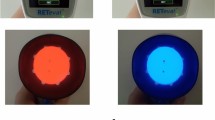Abstract
A system of pupillography is described which can be applied to noncollaborating subjects such as neonates or unconscious adults. A special contact lens adhering to and moved with the eye contains an infrared-light-emitting diode, receptor diodes for the light reflected by the iris, and a green light-emitting diode that provides stimuli to the retina. In this way eye and head movements do not interfere with the measurements. A detailed description of the electronics portion is given. The main characteristics are the use of pulsed light and the use of a preamplifier with a bandpass filter near the receptor diodes. The size of the pupil is obtained in relative values by this method.
Sommaire
On décrit un système de pupillographie applicable à des sujets non-collaborants, p.e. des bébés ou des adultes inconscients. Un verre de contact spécial, adhérent à la cornée, est muni d’une diode luminescente ir, de diodes récepteurs destinées a détecter la lumière ir reflechie par l’iris, et d’une deuxième diode luminescente (verte) servant a stimuler la rétine. Cette construction rend la mesure indépendante de mouvements de l’oeil et de la tete. On donne une description détaillée de la partie électrique de l’appareillage. Les particularités de cette réalisation comprennent la pulsation de la lumière ir et un préamplificateur avec des filtres situé près des diodes récepteurs. Par cette méthode on obtient de valeurs relatives du diamètre de la pupille.
Zusammenfassung
Es wird ein bei nichtkollaborierenden Personen (z.B. Kleinkinder oder bewusstlose Erwachsene) anwendbares System der Pupillographie beschrieben. Ein spezielles Kontaktglas, das sich mit dem Auge bewegt, enthält eine infrarote Leuchtdiode, Rezeptoren für den von der Iris reflektierten Anteil des IR Lichtes, sowie eine grüne Leuchtdiode zur Reizung der Netzhaut. Damit wird Unabhängigkeit von Augen-und Kopfbewegungen erreicht. Es wird eine eingehende Beschreibung des elektrischen Teils gegeben. Die Hauptmerkmale sind die Verwendung gepulsten Lichtes und eines Vorverstärkers mit Bandfilter nahe bei der Sonde. Die Methode liefert relative Werte der Pupillengrösse.
Similar content being viewed by others
References
Bracher, D., Vassella, F., Lotmar, W., Aubert, R., Bütikofer, R. andWaldispühl, C. (1975) Development of a method for assessment of brain dysfunction based on pupillography.Proceedings of the IVth European Congress of Perinatal Medicine, Prague, 1974, G. Thieme, Stuttgart, 521–524.
Casler, J. A., Hoffman, R., Berger, L., Billinger, T. W., Sims, J. K. andBickford, R. G. (1973) Use of photodiode stimulation in clinical and experimental electroencephalography and electroretinography.Electroenceph. & Clin. Neurophysiol. 34, 437–439.
Castenholz, A. (1968) Pupillo—Kymographie.Albrecht von Graefes Arch. klin. exp. Ophthal. Bd. 175, 100–110.
Cüppers, C. (1954) Fortlaufende Registrierung der direkten und der konsensuellen Pupillenreaktion.155, 588–616.
Green, D. G. andMaaseidvaag, F. (1967) Closed-circuit TV pupillometer.J. Opt. Soc. Amer. 57, 830–833.
Lotmar, W., Bracher, D. andBütikofer, R. (1978) The optical basis of contact lens pupillography. To be submitted.
Löwenstein, O. andLowenfeld, I. E. (1958) Electronic Pupillography.Archives of Ophthal. A.M.A. 59, 352–363.
Marquerinck, J. E. (1972) Optimising the signal-to-noise ratio in a television camera preamplifier. Philips Electronic Applications Bulletin 31 (2).
Sherwin, J. (1974) Noise specs confusing? National Semiconductor Corp., AN 104, May 1974
Tietze, U. andSchenk, Ch. (1969)Halbleiter—Schaltungstechnik. Springer, Berlin.
Walsh, F. B. andHoyt, W. F. (1969)Clinical neuro-ophthalmology, Vol I. Williams & Wilkins, Baltimore.
Author information
Authors and Affiliations
Rights and permissions
About this article
Cite this article
Bütikofer, R., Aubert, R. Electronics of contact lens pupillography—A method for binocular stimulating and recording of the pupillary reflex of noncollaborating subjects. Med. Biol. Eng. Comput. 16, 39–44 (1978). https://doi.org/10.1007/BF02442930
Received:
Accepted:
Issue Date:
DOI: https://doi.org/10.1007/BF02442930




